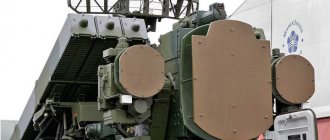| This article may require cleaning to meet Wikipedia's quality standards. |
Shipborne CIWS/Missile launcher
| Pantsir-M | |
| Type | Shipborne CIWS/Missile launcher |
| Place of origin | Russian Federation |
| Service history | |
| In service | 2018-present |
| Used | Russian Federation |
| Production history | |
| Designer | KBP |
| Manufacturer | KBP |
| Produced | 2015-present |
| Options | Pantsir-ME |
| Characteristics | |
| Rate of fire | 10000 rounds per minute |
| Maximum firing range | 20 km |
| Main weapons | Hermes-K and 57E6 missiles |
| Secondary weapons | Two 30x165mm AO-18KD |
| Launch platform | Ship |
Pantsir-M
[1] [2] [3] [4] [5] is a Russian naval Close Combat Counter-Jamming System (CIWS), which entered service in 2018. [6] Pantsir-M is equipped with a friendly or Enemy Identification System, armed with a naval version of the Pantsir 57E6 and Hermes-K missiles. Auxiliary weapons - two six-barreled 30x165 mm rotary cannons GSh-6-30K / AO-18KD (range 5 km). [7] Same as on Kashtan-M. Pantsir-M is fully automated, can hit up to four targets simultaneously at a range of up to 20 km and can operate as a battery of up to four modules. Pantsir-M can intercept missiles flying at an altitude of two meters above the sea surface. If the target is not sufficiently destroyed by the Pantsir's missile attack, it can automatically turn its cannons against it. The Pantsir-M phased array radar, optical-infrared guidance and identification system is based on the 1RS2-1 Pantsir system.
According to Rostec CEO Sergei Chemezov, the destructive power of Pantsir-M is three to four times higher than that of Kashtan-M.
Pantsir-M will replace the Kashtan-M systems in the Russian Navy.
How the "Shell" was created
The outstanding characteristics of the Pantsir were the result of the enormous work of the designers of the Tula KBP. The first prototype was assembled in 1994, and the complex was put into service in 2012. Today, Pantsir not only serves in the Russian army, but is also actively exported and is recognized as one of the most popular anti-aircraft systems in the world.
The Main Directorate of Armaments of the Air Defense Forces ordered the KBP to develop a new anti-aircraft complex in 1990. Initially, the new product was intended to cover the S-300 long-range anti-aircraft missile systems and radar stations of the country's air defense system. Subsequently, the possibility of using it to cover motorized rifle units on the march, destroy infantry and light armored vehicles was considered.
A prototype of a new complex called “Roman” on a Ural vehicle chassis with two 30-mm cannons and anti-aircraft guided missiles was presented to the interdepartmental commission in 1995. “Roman” did not attract much attention from the military: it was unable to fire while actively moving, and the affected area was limited to 12 km. The decision was also influenced by the economic situation of the 1990s.
The first export contracts brought changes to the further development of the project. Foreign partners expected new characteristics from the combat vehicle. As a result, KBP specialists managed to modify the complex and create a real masterpiece in its class. The damage radius has increased, and the function of shooting on the move has been added. This decision changed the opinion about the vehicle among domestic experts, and mass use of the complex began, and in 2012 the Pantsir-S1 air defense missile system was adopted by the Russian army.
Station "Filin": how to blind the enemy
The Ruselectronics holding is developing a new type of non-lethal weapon, a prototype of which may appear as early as 2022. A new device is being created at Opytny on the basis of the 5P-42 Filin visual-optical jamming station.
“Filin” is used on surface ships of the Russian Navy to suppress visual-optical and optical-electronic surveillance channels and aiming of small arms and melee weapons at a distance of up to 2 thousand meters. The action of "Owl" is based on modulation of the brightness of light radiation - low-frequency fluctuations in brightness excite the optic nerves and cause temporary visual disturbances.
Application of the Pantsir-S1 air defense missile system
The complex received combat use during the conflicts in Syria and Iraq.
Iraq. Used by the Iraqi army. As a result of the Islamist attack on Iraqi military forces in 2022 using drones, the Pantsir C1 complex was used. Of the eight targets, all were hit with cannon fire; there were no casualties among the Iraqi army.
Syria (Khmeimi airbase). The air defense missile system was used by the Syrian army and the Russian Aerospace Forces. The attack on the Syrian air base in 2022, where the Russian air forces were based, was carried out using drones that carried explosives; out of 80 air targets, 40 were destroyed by electronic warfare (EW), and 30 targets were suppressed by the Pantsir-S1 complex using missile and cannon weapons. The airbase did not receive any damage from the enemy.
Main tactical and technical characteristics of Pantsir-S1:
- Ammunition - 12 missiles, 1400 shells.
- Range – 20 km.
- The mass of the missile warhead is 20 kg.
- Deployment time is 5 minutes.
- Crew – 3 people.
- The number of tracked targets is 20.
- The maximum altitude for hitting targets is 15 km.
- Reaction time – 4-6 seconds.
- Detection range – 36 km.
- The height of the lesion is 15 km.
- The minimum height of the lesion is 5 m.
- Caliber – 30 mm.
- The range of cannon weapons is 4 km.
- The weight of the projectile is 840 grams.
- Barrel endurance is 8000 shots.
- Dispersion area – 2 square meters.
- Number of antennas – 3.
- Field of view – 2 modes.
- Pointing speed – 100 degrees per second.
"Palm" championship on the water
The Palma naval anti-aircraft missile and artillery complex was developed within the walls of the Precision Engineering Design Bureau named after A.E. Nudelman (part of the High-Precision Complexes holding company) and has been supplied to the Russian Navy since 2011.
The complex is designed to destroy air and surface attack weapons at the close lines of a ship's defense, including anti-ship missiles flying at low and ultra-low altitudes, and small uninhabited speed boats. At the same time, Palma is a component of the defense not only of ships, but also of naval bases, coastal infrastructure, airfields and other particularly important facilities. Along with its main purpose - missile defense - Palma can hit airplanes, helicopters and boats.
ZRAK "Palma" is a two-in-one system that combines not only missiles, but also high-speed automatic guns. The complex's armament includes two modernized six-barreled 30-mm AO-18KD automatic cannons and eight Sosna-R high-precision anti-aircraft guided missiles. In terms of speed characteristics, Sosna-R is ahead of foreign analogues - the maximum rocket speed reaches 900 m/s. High speed also provides high firepower. “Sosna-R” of the “Palma” complex operates at 10 km, which cannot be compared with the 15 km range of missiles of the ship’s “Osa” air defense system, but a hit from “Sosna” due to its high speed will be more destructive.
The complex's weapons are controlled through the latest optical-electronic control system (OECS), which was specially designed for the Palma air defense system. The ZRAK Palma missile control system is laser-beam.
Thanks to this set of technical equipment, Palma is capable of detecting, tracking and destroying targets day or night, including in bad weather conditions that often occur at sea. The new OESU increases the effectiveness of the combat use of the complex, which is important when firing at high-speed and low-flying targets.











